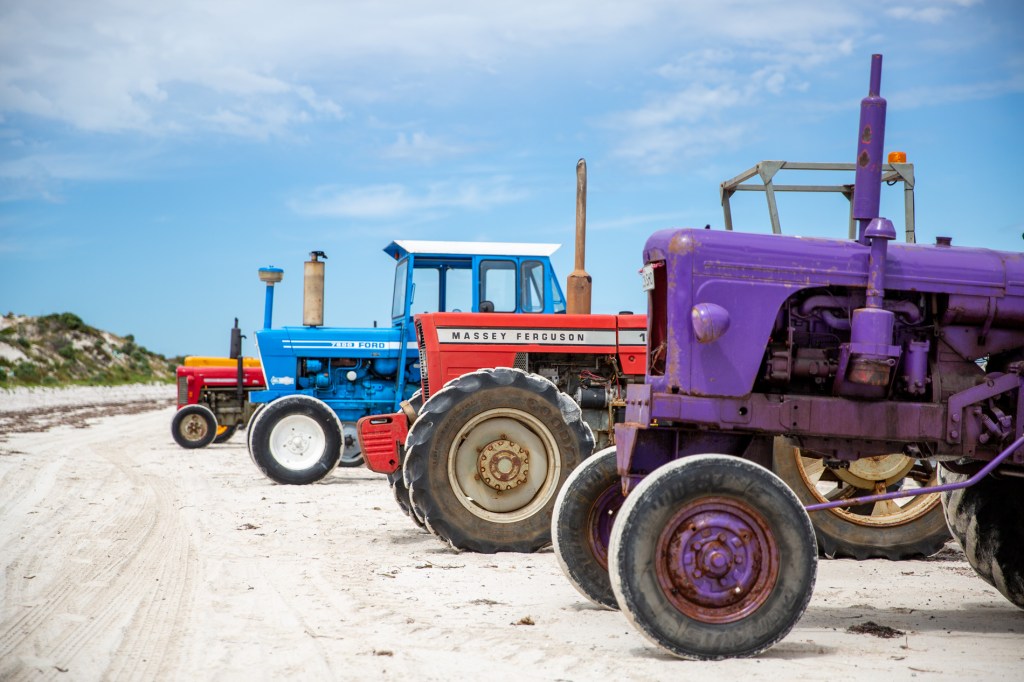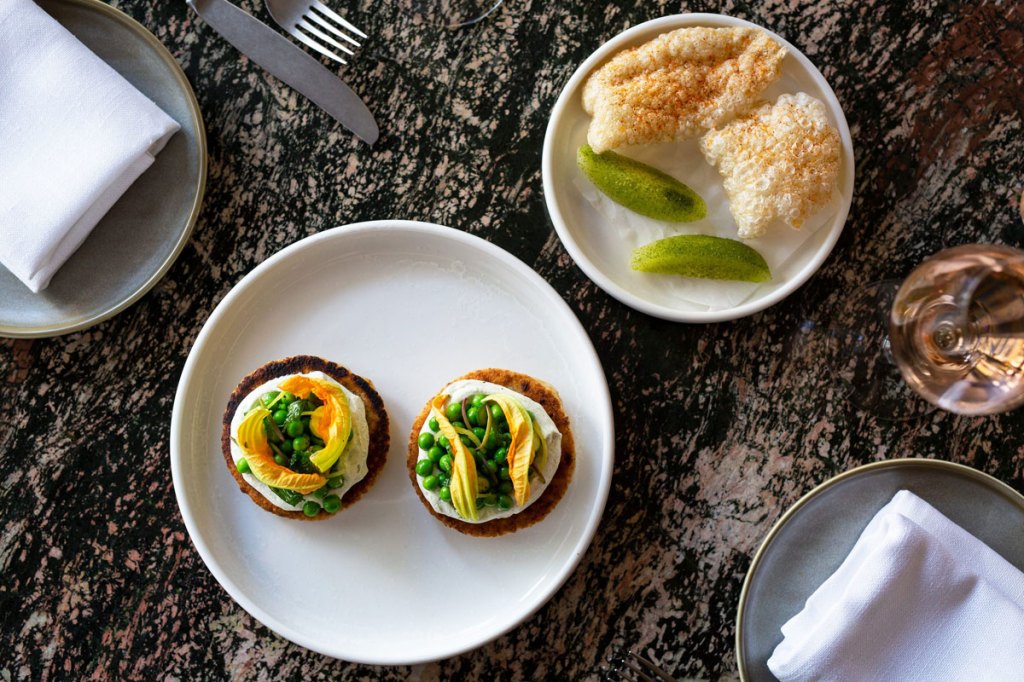The turning tides of South Australia’s Hardwicke Bay
The rustic charm of this under-the-radar coastal town has been treasured for generations, but how much longer will the weathered shacks and rusty tractors continue to rule the sands of Hardwicke Bay?

It’s a place where life shuffles along a little slower. Where the only person you can see for now is a man casually mowing the lawn of his tiny shack within stone’s throw of the sparkling sea.
Where another shack’s lonely Hills Hoist stands in defiance of its corrosion, as if desperately holding on to its million-dollar view.
Where a brigade of rusty, multi-coloured tractors rules the white summer sand as fishermen launch their boats in the glittering turquoise water that stretches out waist-deep for hundreds of metres.

Hardwicke Bay. Photograph Adam Bruzzone.
These dilapidated tractors are parked next to corrugated iron shacks and fibro huts, for now, half-covered in tarps that do little against the salt air, somehow also embodying the carefree attitude of the people who holiday here.
Why are the tractors here? Because the ocean is teeming with whiting, and with such shallow water and no boat ramp, a tractor is essential for launching a vessel. Fishermen give each other a thumbs up from behind the wheel of their rumbling tractors, boat trailers in tow.
Each year, thousands of holiday-makers drive straight past the turnoff to Hardwicke Bay on their way to the Yorke Peninsula’s famous Innes National Park. Blink, and they miss it. Unlike other towns on the coast, in Hardwicke Bay, there isn’t a jetty; no boat ramp, pub or caravan park. There is one general store, but it’s been shut for some time.

It’s the rustic charm and pristine coastline of this place that has wooed generations of South Australians ever since the 1950s when fishermen and farmers planted the first ad-hoc tin sheds on the seafront under leasehold arrangements.
While many of the original shacks still stand, signs of change are evident.
New beachfront homes stand shoulder-to-shoulder with surviving originals.
The town’s first-ever million-dollar property sales went under the hammer last year, signalling that the locale is becoming recognised as a boutique destination.
The pristine Flaherty’s Beach stretches for kilometres to the south of Hardwicke Bay and was judged fourth in Tourism Australia’s top 10 beaches of 2022.
The recognition is exposing a new generation of holiday-makers to this idyllic destination, while also marking a slow, but possibly inevitable, erosion of the town’s rustic nature.

You might like
Adelaide couple Craig Harrison and Emma Anderson purchased a rusty, old beachfront shack nearly 10 years ago, wanting a weekend getaway where their children would be free to just be kids.
With children of their own and as foster parents who have given emergency care to many others, Craig and Emma wanted a location for their children to play in the rock pools and safe shallow water within eyesight of their shack.
“Many of the children who’ve come through our house have never been to the beach before and this has been so nice for them,” says Emma. “Buying the shack was a big step at the time, but we looked at it as an investment in our children’s memories. We’re so glad we did.”
Some buyers would’ve happily bulldozed the corrugated iron “hotbox”, which was full of old fishing paraphernalia and odds and ends collected by the previous owner over 70 years.
“We walked in here and it was like: ‘Wow, this is going to be a challenge’,” recalls Craig. “But we just couldn’t beat the location. The front door is literally three metres from high tide – where else can you get that?

“It hadn’t been touched since the ’50s and it was a museum of old fishing paraphernalia. It was just a tin shack with a Masonite ceiling but we were lucky that there was no asbestos, and it had a concrete floor.
“On a summer’s day, it’d be 50 degrees in here and you would burn your fingers on the tin roof. It was horrible and unusable. You’d have to take your folding chairs and sit waist-deep in the water with an umbrella.
“A mate and I stripped the whole thing back to tin, added insulation and clad it with plywood. We added an IKEA kitchen and turned it into this beautiful little Tardis that has everything we need.”
The shack had been in the same family ever since it was built by a fisherman in the ’50s. In recent times, a granddaughter of the original fisherman reached out to Craig and Emma and was touched to discover that the family had kept the old structure.
“She’d assumed we would’ve just knocked it down, so when she found out we’d kept it, she couldn’t believe it,” says Craig.
“She talked about being down here with her sisters when she was a child and they used to fry themselves in the sun and catch squid.”

Back then, farmers and fishermen had cleared all the vegetation from the front of their shacks so to be on absolute beachfront. Craig and Emma re-planted and nurtured new native vegetation to help build a buffer against the sea.
In the past few years, some of their neighbouring shacks have been replaced with new ones. New planning laws state that properties must now be built well above the high tide mark to
protect against storm surges.
“Unfortunately, it means it’s lost some of that charm that we love about it down here. It was inevitable, but it still takes a little of the magic away. You can’t fight progress,” says Emma.
For now, the couple continues to spruce up the little shack where possible, creating even more memories.“It is sad, but the shack won’t last forever,” says Craig.
“It might be a storm that eventually finishes it off but for now we’re holding it together with gaffa tape and hope.”

Further south along the town’s foreshore is the two-storey holiday home of Vlad Borovac and Kerry Norris, who bought their modern foreshore escape in June last year.
As owners of the Empress Homewares store at Norwood, the couple and their two boys Akasha, 14, and Raf, 11, had previously enjoyed travelling regularly to India to meet with manufacturers.
But the pandemic took away their travel options.
The passing of Vlad’s beloved father last year spurred the family to consider a new way to spend time together and so began a search for a holiday home on the Yorke Peninsula.
At first, a modest beach shack was all they wanted.
Subscribe for updates
“We did a lot of research and travelled about 8000 kilometres back and forth to the Yorke Peninsula to see if we could find a shack – a humble tin shed or fibro on the beach was all we were after,” says Kerry.
“We went to every little nook and corner of Yorke Peninsula, but there was nothing on the market. Once we’d been to Hardwicke Bay, that was it, we fell in love. Sometimes, a place will find you, and that’s how we feel about Hardwicke Bay.”

Vlad Borovac and his sons Akasha and Raf enjoy the sunset at their beach-front holiday home. Photograph Adam Bruzzone.
Vlad explains: “It was the untouched beauty of the bay, the safe and calm shallowness of the water for the kids, the relaxation and the tractor factor. We love the tractors.”
Their plans for a tin shack were discarded when they fell in love with a modern home that they could use themselves and rent out as holiday accommodation. It became the town’s second-ever million-dollar sale, which happened just months apart.
In between leasing it as holiday rental, Sol Living, the family has stayed there as much as possible. “When we first got into the house we just thought, ‘yes, we’re home’,” says Vlad.

The picturesque beachfront of Hardwicke Bay features a mix of new holiday homes and corrugated iron and fibro shacks from last century. Photograph Adam Bruzzone.
“It’s such a great lifestyle. We love the sunsets and sitting there being mesmerised by the ocean and the tranquillity of it all. Even in winter when it’s stormy, it’s just brilliant with the fire going.
“It’s a beautiful little place and so unique compared to some other beaches on Yorke Peninsula. Having barbecues at sunset, hanging around playing pool with the shed doors open and seeing the ocean, it’s wonderful. Hardwicke Bay has this gentle energy and untouched beauty about it. There is a sense of sadness each time we leave.”

Vlad Borovac and Kerry Norris’ holiday home at Hardwicke Bay. Photograph Adam Bruzzone.
Akasha and Raf are avid young fishermen who enjoy dropping a line at beaches all over the peninsula, quickly becoming the next generation of passionate anglers.
With deep appreciation for the nostalgia of the old shacks and watching the tractors roll past each day, the family hopes the town will retain its charm. “It’s two-fold: I hope Hardwicke Bay will stay peaceful, but we also want to share the love for it – I hope it doesn’t get much bigger, but I don’t mind sharing,” says Kerry.
There are very few services in Hardwicke Bay, but if you need a lawn mowed, holiday home cleaned or maintenance done, Ashley Gordon is your man. Formerly a diver for the underwater recovery unit in Special Tasks and Rescue (STAR) force, Ashley semiretired and moved to Hardwicke Bay five years ago.
Chasing a simpler life on the coast but just over two hours from Adelaide, Ashley purchased his Hardwicke Bay home in 2017. Homes were easier to come by back then – his property, a few blocks back from the foreshore, had been on the market for 22 months.
“At one stage before Covid, there were 45 homes and blocks of land sitting on the market, and right now there’s only one and that’ll be gone in a few days,” says Ashley. “They’re selling in no time and it’s not just here, there’s hardly anything on the market right across the peninsula.”
The demand is spelling out what could be the eventual demise of the bay’s many rustic beachfront shacks.
“Give it five to 10 years and I think, unfortunately, a lot of those old shacks could be gone. They’re already starting to go along the foreshore,” says Ashley.

Hardwicke Bay Progress Association president Ashley Gordon has seen a recent surge in demand for property in the town. Photograph: Ben Kelly.
“Hardwicke Bay’s not as well-known as Point Turton, Corny Point or Marion Bay. They all have caravan parks and pubs, but Hardwicke hasn’t got that, so unless you’ve got a shack there’s nowhere to stay. People like it because it’s a bit quieter and you’ve got to be self-sufficient.”
Ashley’s large tractor came with the house. Unlike some others, he keeps it well-maintained and undercover so he can easily launch his boat to go scuba diving for crayfish. “If you haven’t got a tractor or can’t borrow one, you’re pretty well stuffed. I saw someone in a $100,000 Land Cruiser get bogged in water up to his doors,” says Ashley.
Ashley is the president of the town’s Progress Association which has overseen a number of projects to provide amenities such as barbecues and a playground, with the association currently building a beach lookout and shelter. They have even planted a little grove of quandong trees, dubbed Quandong Corner.
“There’s about 250 full-time residents, the rest are shackies or visiting tourists,” says Ashley.
If a boat ramp is ever built in Hardwicke Bay, it would be the kiss of death for the town’s population of tractors. For now, they continue to defy the rust to rule the beach.
“It really comes alive over summer,” Ashley says. “There will be 30 or 40 tractors along the beach with families set up playing cricket and relaxing all along Flaherty’s. When it’s full of people on a nice day, it’s glorious.”
This story first appeared in the January 2023 print edition of SALIFE Magazine.


